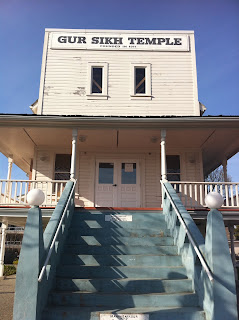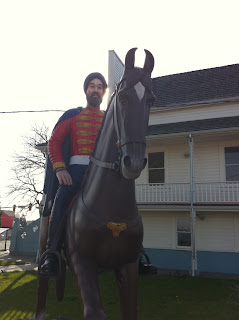My exchange experience in Canada has been very positive and I gained many new insights to North American culture as well as how my own background compares to that. Academically as well as personally I learned much, and much of it I think I will be able to apply in future. The study of diaspora was not one of my main focuses throughout my university years and the concept as such was never all that clear to me. After having studied diaspora in a country with many different diasporas and in a program in which the courses seemed very interconnected the study of diaspora theory made a lot more sense and was much more interesting than I had anticipated.
I had previously only once been to Canada and then only for a short trip to Vancouver so I did not exactly know what to expect. Abbotsford is not exactly a metropolis and at first it seems rather dull to live there. However, after a while and after meeting a lot of people there was really never a dull moment. The Canadians I met were are really friendly and it did not seem superficial, their friendliness seemed sincere. Compared to Germany this is quite different since here friendliness can be a rarity at times or unnoticeable if one is not used to the dry German friendliness. I also found most Canadians really helpful in all kinds of situations, which was lucky for us when we had two flat tires and no cell phone reception in the middle of the mountains.
I knew before-hand that Canada is a very multicultural country that takes pride in having many different people from different parts of the world with different cultural backgrounds and different religions. But not until actually being in Canada for some time and especially because of the courses I took did I begin to understand what it actually means to be a multicultural country. Going to Canada and seeing what issues and problems they have to deal with to ensure the happiness of so many different people taught me a lot about the issues and problems Germany faces with integrating the many different cultures and peoples.
The program as such taught me much about myself as well. By participating in a program mainly focused on cultural studies, my interest in and passion for Literature really has been reinforced. However, learning about different cultures especially in the connection with religion has also shown me that I keep coming back to the influences of religion within literature. The interest in the contextual understanding of literature in combination with religion was and remains my main interests in my academic life.
Throughout the courses here I discovered academic skills that I think will be rather useful considering my wish to have a career within the academics. Because I had to apply skills to different field of study than I usually do I became much more aware of them. I am now more aware of that I have an attitude of inquiry, a certain inquisitiveness and critical questioning of the things that surround me. I have also been able to further develop my rhetorical skills and interpretational skills.
I also feel as though my framework of reference has been broadened. For most of the past five years I have mainly focused on studying literature from a particular area and a particular period, always specializing more and more on a smaller area. Being encouraged to take quite different kinds of courses here has allowed me to broaden my horizon when it comes to possible fields of study.
Often times people who have never been to Canada or the USA ask how it is different and want to know specific things. I think it is really difficult to pinpoint specific details, since Canada and Germany do have many similarities and are both so called Western countries. However, there are differences and once they have been noticed they seem so obvious. One of the differences I have noticed is that sports and the collective watching of sports has a much bigger importance in Canada. People love to go to bars that show ice hockey, basketball or even soccer at times. It is an event that you go to with many friends, you dress up in the teams jersey and have a couple of beers and some food. Of course this is also done in Germany and other places but I always felt as though much more people do this in Canada, even the girls come out to watch the sports if even to just hang out with friends.
Although activities were rather limited at times, especially in Abbotsford, people would always be doing something. Many activities were organized by the university or by the residence and it was always a lot of fun to attend those events. The University of the Fraser Valley is much smaller than the Westfälische Wilhelms-Universität, but people seemed a lot more connected to the idea of belonging to a particular university. Students would identify a lot more with their university than what I am used to from Germany. A certain sense of school spirit was noticeable and created a much more unifying experience than what I have known so far. Even the residence seemed much more eager to create a certain feeling of home and belonging than what I have noticed in Germany. Here if you live in residence, which is not the most common thing to begin with, you usually simply live there. In Baker House we often even left the doors open so as to be able to talk to people walking by. Also I think I never ate my dinner alone but people would always come over and we would eat together or I would go to somebody else’s room. So much more a feeling of community was created based on living in the same residence and going to the same university.
Another difference was that a ‘historic site’ would be a place a little more than a hundred years old, like the Gurdwara that was finished in 1911. In Germany a historic site can sometimes even be from BC such as the site of the Varusschlacht or Haitabu.
I was also amazed at the diversity of religion I found in Canada. The Fraser Valley is known as the Canadian Bible Belt and I was not disappointed. In comparison to a city like Münster for example, that mainly has catholic churches, protestant churches, a synagogue and some mosques, Abbotsford alone housed four Gurdwaras, catholic churches, protestant churches, various shia islam prayer houses, 7th day Adventists, Mormons, Menonites, First Nations reservoirs, and probably all kind of Christian sub group there is. At times it seemed like every second house had a sign in front of it proclaiming it to be some different kind of religious place of worship.
By being ‘displaced’ myself during my stay in Canada I feel as though I was much better able to at least partially understand what it means to be part of a diaspora. Being friends with Canadians as well as many international students, by talking to them and seeing them every day, has taught me to understand what it means to feel alienated from the dominant culture, what the longing for home means but also the ambivalent feeling of wanting to assimilate and belong but still retain what one has learned at home and what one grew up with. My time in Canada has introduced me to many new and different cultures that I doubt I would have met with here in Germany. Although we all came from different parts of the globe I feel like we all were part of our own little global community within Baker House and I think that the friendly climate towards other cultures that is present in Canada was an important factor that helped enable so many different people to meet and be friends.





